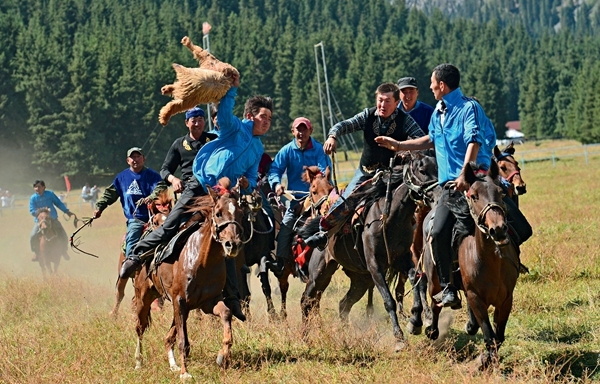Pearl of the Ancient Silk Road
 0 Comment(s)
0 Comment(s) Print
Print E-mail China Today, August 30, 2017
E-mail China Today, August 30, 2017
Ancient Silk Road
As the capital of Xinjiang Uygur Autonomous Region, Urumqi is its political, economic and cultural center, and an important portal of China’s opening-up. Historically, it was of strategic importance on the new northern branch of the ancient Silk Road as a site of exchanges between Eastern and Western cultures. Today, as a core region of the Silk Road Economic Belt, Urumqi has become an open and inclusive city of cultural diversity.
Surrounded by hills and girdled by waters, Urumqi owns vast fertile land. The ancient Urumqi River flows through the city from south to north, and the graduating ridges and peaks of the grand Tianshan Mountains span the southern end the city. Mount Bogda is snowcapped all year round. Crystal clear Tianchi Lake on the mountainside is a famous resort.
|
|
|
Nanshan Natural Scenic Area in Urumqi. |
Han, Uygur, Kazak, Hui and Mongolian are among the 47 ethnic groups resident in the city. Various cultures, arts and customs have shaped the city through its associations with historical figures and cultural heritage. Urumqi’s colorful scenery of distinct costumes and vibrant cultural activities, along with its hospitable people, attract visitors from the rest of China and beyond.
New Northern Branch of the Ancient Silk Road
Urumqi is Mongolian for “beautiful pasture.” More than 2,000 years ago, the city was a point of strategic importance on the ancient Silk Road on account of its various passageways connecting ancient China with the West. The Silk Road thus constituted not just one but various paths, trodden throughout different historical periods.
One such trail started from the northern slopes of the Kunlun Mountains and led to today’s Iran, and on to the Indian Ocean. It is regarded as the southern branch of the road.
|
|
|
The Tianshan Mountains naturally divide the vast Xinjiang region into two parts. |
Another started from the south side of the Tianshan Mountains and crossed the Pamirs to Central Asia and the Persian Gulf. This was the northern branch. Both are on the southern side of Tianshan Mountains. The third path was formed north of Tianshan Mountains during the Western Han Dynasty (202 BC - AD 8). It led to various Mediterranean countries, and also became known as the northern branch. Consequently the original northern branch was renamed the central branch.
The section of the northern branch in Xin- jiang was called the new northern branch. It started in Kumul and led via Barkol Lake to Jimusar, Urumqi, Ili, and then westward. The prosperity of the new northern branch was due to its strategic military position. The ruins discovered on the south side of the Wulabo Reservoir in the southeastern suburbs of Urumqi are those of a city that held a key position in military operations in today’s Luntai County, original location of the Protectorate of the Western Regions.
The Tianshan Mountains divide this vast region of Xinjiang into two parts. Prior to the Tang Dynasty (618-907), the central government’s administration and cognition focused on south Xinjiang for many years. As an important supplement to the existing two branches, the new northern branch opened up Xinjiang’s northern inland, so gradually making it a crucial commercial hub that linked oriental culture with that of the civilizations of India and Persia, and also a strategic region throughout history.
|
|
|
A lamb-catching contest is part of the local folk festival. |
Established during the reign of Emperor Taizong (598-649) of the Tang Dynasty, Anxi Protectorate had jurisdiction over both north and south Xinjiang, and connected with Persia in the west. Beiting Protectorate was established during the reign of Tang Empress Wu Zetian (624-705). It governed the extensive nomadic areas between the northern Tianshan Mountain and Balkhash Lake in the south, and maintained the solidarity of the Western Regions and safety of Silk Road for some considerable period. A province was established there during the Yuan Dynasty (1271-1368) to strengthen military control over Central Asia.
As a heavily guarded fortress in earlier dynasties, Urumqi was not well developed. Through till 1755 it was little more than a garrison for troops sent by the Qing government to pacify civil strife in Junggar. Large-scale exploitation, in the forms of agriculture, commerce and manufacture, took place for purposes of expanding the population and establishing commercial trade. The ultimate aim was to make Urumqi a city of prosperity and abundance.
Multi-cultural Convergence
Urumqi’s distinct character has formed throughout its history due to the sustained commingling of peoples of various ethnic backgrounds.
The 13 ethnic groups that have dwelt longest in the city comprise Han, Uygur, Hui, Kazak, Manchu, Xibe, Mongolian, Kirgiz, Tajik, Tatar, Uzbek, Russian, and Daur peoples. Among them, the Uygur and Hui have centralized residence, while others live both in scattered and condensed communities.
Xinjiang’s cultural diversity has gained it the reputation of “home of song and dance.” Uygur folk music and dance, with a history that goes back centuries, is particularly admired. The classical Twelve Muqams, a type of melody used to guide improvisation and composition, have been played in Xinjiang for generations.
Religious tolerance also embodies Urumqi’s melding of eastern and western cultures. Buddhism came to Xinjiang in the first century BC, and through to the mid-20th century a number of religions were introduced, including Zoroastrianism, Manicheaism, Islam, Catholicism, Christianity, the Orthodox Eastern Church, and Taoism. This conglomeration has created a splendid religious civilization. Evolution over the centuries has culminated in an environment where Islam is the predominant religion while among many others that coexist.
Important places of worship in Urumqi include the Shaanxi Great Mosque, the Southern Mosque, and the Tatar Mosque. The Shaanxi Great Mosque is the oldest and grandest in the city. Built in the reign of Qing Emperor Qianlong (1736-1795) and Emperor Jiaqing (1796-1820), it was renovated in 1906. Unlike other great mosques in Xinjiang, it is a Han-style building incorporating Islamic architectural features. Its main part is a post and panel structure ornamented with encaustic tiles. Supported by 40 Chinese red pillars, the magnificent main temple hall features an arch carved with sections of the Koran. The double-eave octagonal pavilion to its rear is for purposes of observing the moon and declaring fasts. Believers come here at weekends and on festivals to pay respects. In recent years, Muslims from West and South Asia have also come to the Shaanxi Great Mosque to attend prayers.
Amazing Natural Scenery
Its rugged terrain and diverse climatic conditions endow on Urumqi abundant tourism resources. Around the city is a steep icy gorge with intact carved geological outcrops, and a vast fossil field. This makes it ideal for trekking, skiing, and exploring. A kaleidoscope of vertical natural landscape offers abundant choices.
Located in Urumqi County, south of Urumqi City, Nanshan Scenic Area features natural scenery and the chance to observe ethnic minority folk customs. It features soaring mountain peaks, lush forests, mountain streams, and breathtaking scenery. The area also has scores of ravines running parallel from east to west, serene natural prairies, and sightseeing destinations that offer an escape from the summer heat.
As a national AAAA level tourist attraction, Shuimogou Park offers an abundance of natural and cultural scenic spots. Surrounded by five mountains – Qingquan, Hongqiao, Wenquan, Shuita, and Xuelian mountains, and Shuimogou River, the park is a haven of rivers, forests and flowers.
Yan’erwo in Urumqi’s southern suburb is a noted scenic area and site of the tombs of Chen Tanqiu and Mao Zemin, two revolutionary martyrs and founders of the Communist Party of China. Yan’erwo forest is Urumqi’s natural green air-purifier, and also a natural sandstorm barrier. The scenic area gives priority to protection of ancient trees and also offers ecological tourism.
Emblematic of the city, Red Hill Park is at the heart of Urumqi City. At an altitude of 910.8 meters, the hill is so named due to its reddish- brown colored rock. Summon and maintain the energy to make reach the Red Hill summit and your reward will be a fantastic, bird’s eye view of Urumqi.








